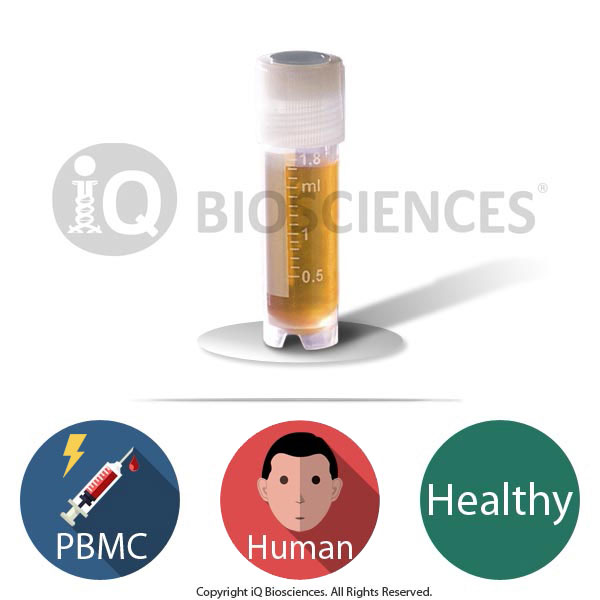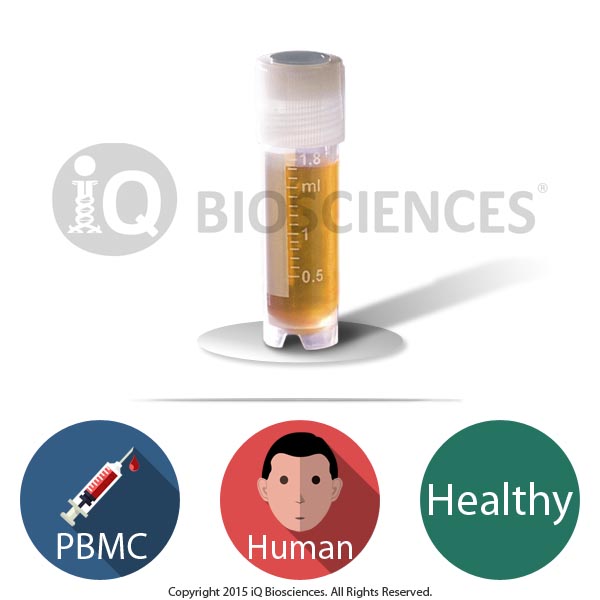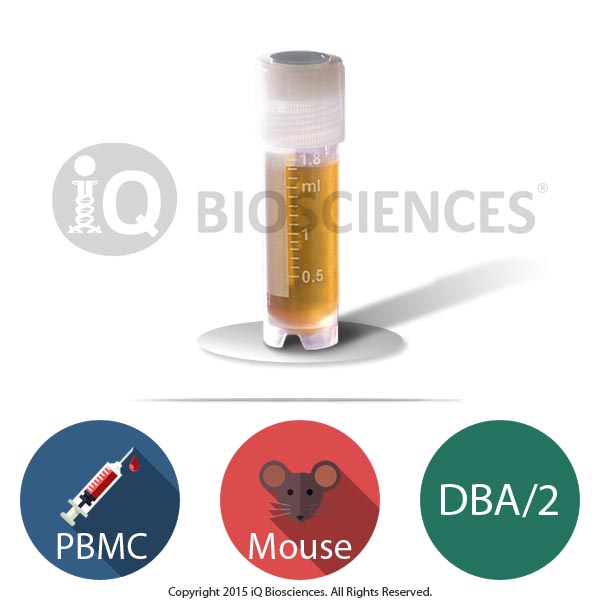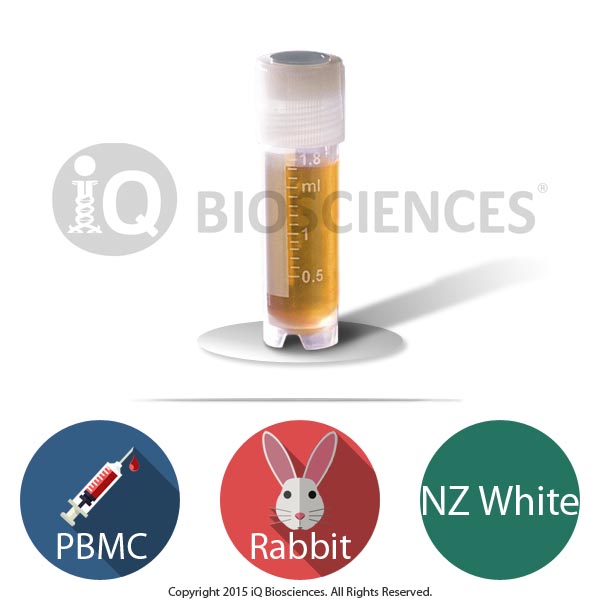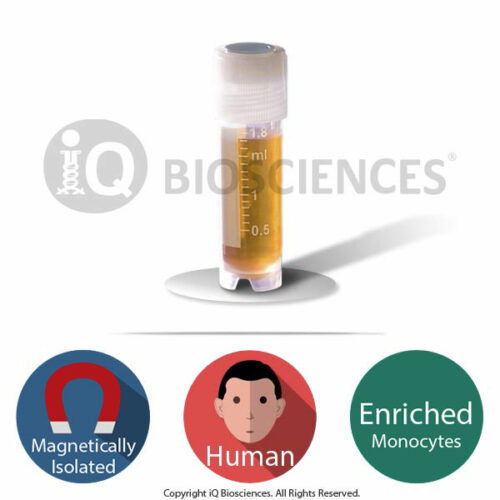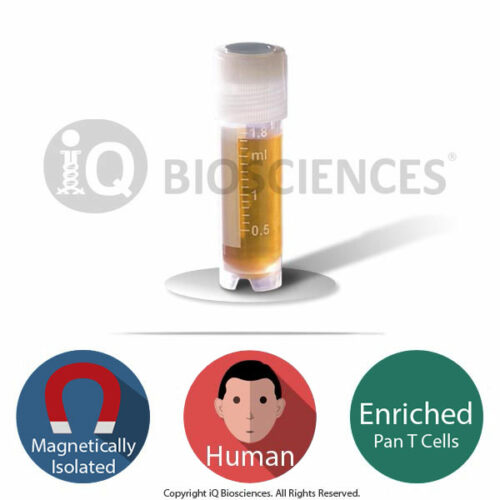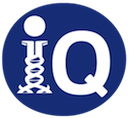- High-quality irradiated PBMCs from healthy blood donors sourced from a world-renowned blood center
- High viability (> 80%) after thawing
- Used as stimulator cells for a wide variety of immunology-based applications, including proliferation and cytotoxicity studies
- All orders come with an iQ Certificate of Analysis
- Normally ships out same business day
Human Irradiated Peripheral Blood Mononuclear Cells (PBMCs)
$340.00 – $530.00
Description
About Our Donors
Our healthy human peripheral blood mononuclear cells (PBMCs) are sourced from a renowned world-class blood collection center that has been a pioneer in many screening processes. All donors have been tested for various infectious diseases, including HIV and Hepatitis B/C, as well as normal levels of hemoglobin. Further, donors undergo a screening questionnaire to disclose vital statistics, medication, cancer history, and travel history to ensure that they are healthy and their PBMCs will reliably serve your research endeavors.
About Human PBMCs
Human PBMCs are cells isolated from the peripheral blood of human donors. They are specifically isolated by performing a density centrifugation at room temperature under sterile conditions to remove red blood cells. This process leaves a mixture of cells that comprise mostly of white blood cells that include T cells, B cells, NK cells, and monocytes, which can be used in a variety of immunology-based applications.
Because of the cell populations found in PBMCs, they are widely used by scientists for the study of immunology, infectious diseases, cancer, and autoimmunity. In addition, certain subsets of cells in the PBMCs can be isolated to perform experiments with the specific goal of interrogating the role of that distinct population in a certain experimental context.
Application Summary for Human Irradiated PBMCs
Human irradiated PBMCs are commonly used as antigen presenting cells, stimulation/feeder cells, or target cells in a wide variety of immunology-based applications. Unlike unirradiated cells, these cells will not divide or respond to stimulus. However, the antigen presenting cells found in the peripheral blood, such as dendritic cells, macrophages, and B cells, can still present antigenic peptide to stimulate exogenously added CD4 and CD8 T cells in which their TCR recognizes the peptide. In these types of co-culture studies that require antigen presentation, peptide is added to the irradiated cells, which then present the peptide to activate T cells in order to produce cytokines, proliferate, and perform cytotoxicity.
Irradiated PBMCs can also be used as stimulator cells in mixed lymphocyte reactions (MLR). In this type of experiment, the irradiated cells and exogenously added effector cells, which are typically T cells, are of different genetic backgrounds. In particular, they are of different MHC haplotypes. The effector cells will respond to the difference in the MHC haplotype and begin to produce cytokines, proliferate, and perform cytotoxicity.
Isolation of PBMCs
Peripheral blood is obtained from responsible facilities that have many years of experience collecting samples. Since the facilities are local, the blood is quickly transported to iQ Biosciences’ laboratory for processing.
Once at our lab, PBMCs are isolated by performing density centrifugation with Ficoll, a high molecular weight sucrose solution, to remove red blood cells under sterile conditions. Depending on the species (human or non-human) of blood, either 1.077 or 1.084 g/ml Ficoll is used, resulting in a perfect layer of mononuclear cells that are separated from plasma, platelets, granulocytes, and erythrocytes. Additional quality control steps are taken to isolate and prepare PBMCs that ensure the highest viability for cryopreservation and downstream experimental applications.
Irradiation of PBMCs
After isolation of PBMCs, the cells are irradiated using X-ray radiation at a dosage that stops cell division, but permits retention of cellular processes, including antigen processing and presentation.
Cryopreservation and Storage
Our human irradiated PBMCs are cryopreserved carefully using iQ Biosciences’ cryopreservation protocol that ensures high viability (> 80%) after thawing.
Cells should be stored at < -120°C once they are received, such as within a liquid nitrogen tank (vapor phase).
Quality Control Process
We implement random sampling per lot to test for viability and cell counts to ensure they meet specifications, which are recorded on the Certificate of Analysis that is included with each shipment. Cell counts are obtained using a manual hemocytometer and then cross-referenced with an automated cell counter. Each lot is also characterized for unique cell populations by immunophenotyping, in which the results are also recorded on the Certificate of Analysis.
Additional information
| Available Size(s) | |
|---|---|
| Cell Type | |
| Format | |
| Species | |
| Tissue Type | |
| Viability | > 80% |
We are Committed to Ethical Practices
iQ Biosciences’ human primary cell products are lawfully obtained in accordance with Local, State, and Federal U.S. requirements, and the collection of cells complies with ethical requirements. Our cells are obtained from normal or disease patient volunteers participating in a donor program that is approved by an Institutional Review Board (IRB) or Human Subject Committee. A signed and witnessed consent form is obtained from donor volunteers prior to starting the collection protocol. Strict controls on personal identifiers of volunteers are in place in order to protect their privacy.
For US customers, we ship via FedEx Overnight Shipping. Shipping charges will vary per shipping address (based on ZIP code) and are estimated to be $140.
For international (non-US) customers, we work closely with you and our couriers to ensure all necessary documentation is in place for international shipments to significantly reduce the chance of delays at Customs. For the export of non-human primate samples, this includes preparing CITES permits, as well as any other documentation as required by country. Please submit an inquiry to orders@iqbiosciences.com for your estimated time of delivery and shipping charges.
Austria
Hölzel Diagnostika Handels GmbH
Tel: +49 221 126 02 66
Email: info@hoelzel.de
Web: https://www.hoelzel-biotech.com/
Canada
Cedarlane
Tel: +1 (289) 288-0001
Toll Free (North America): +1 (800) 268-5058
Fax: +1 (289) 288-0020
Email: sales@cedarlanelabs.com
Web: https://www.cedarlanelabs.com
China
BIOHUB INTERNATIONAL TRADE CO., LTD.
上海起发实验试剂有限公司
Address: Chuansha Rd #6619, Pudong, Shanghai, Zipcode: 201200 P.R.China
Tel: 0086-021-50724187
Phone: +86-15921799099
Fax: 0086-021-50724961
Email: sale3@78bio.com
Web: www.qfbio.com
European Union
Caltag Medsystems Ltd.
Email: office@caltagmedsystems.co.uk
Web: https://www.caltagmedsystems.co.uk
tebu-bio
Web: https://www.tebu-bio.com
Or Find a local contact
Germany
Hölzel Diagnostika Handels GmbH
Tel: +49 221 126 02 66
Email: info@hoelzel.de
Web: https://www.hoelzel-biotech.com/
Zageno
Web: https://zageno.com/
Ireland
2B Scientific Ltd
Tel: +44(0) 1869 238033
Fax: +44(0) 1869 238034
Email: sales@2BScientific.com
Web: https://www.2bscientific.com
India
Cell & Gene BioSolutions Pvt. Ltd.
#478 C, SLV Complex, Raghavendra Swamy Mutt Road
Opp. Turahalli Water Tank, Turahalli, Subramanyapura Post
Uttarahalli Hobli, Bengaluru-560061, Karnataka, India
Phone: +91 97317 14670
Phone: +91 98809 25033
Email: info@cgbios.com
Web: www.cgbios.com
Japan
Cosmo Bio Co., Ltd.
Tel: +81 (03) 5632 9610
Fax: +81 (03) 5632 9619
Email: nsmail@cosmobio.co.jp
Web: https://www.cosmobio.co.jp
Qatar
Sedeer Medical Services and Trading LLC
Tel: +974 4434 9191
Email: info@sedeer.com
Web: https://sedeer.com/
Singapore
Omnicell Pte Ltd
Tel: +65 6747 0201
Email: enquiry@omnicell.com.sg
Web: https://omnicell.com.sg/</a
South Korea
BioClone
Tel: +82-2-2690-0058
Email: bioclone@bioclone.co.kr
Web: http://www.bioclone.co.kr
Switzerland
Hölzel Diagnostika Handels GmbH
Tel: +49 221 126 02 66
Email: info@hoelzel.de
Web: https://www.hoelzel-biotech.com/
Taiwan
Hycell International Co. Ltd.
Tel: +886-2-2877-1122
Fax: +886-2-2876-1520
Web: http://www.hycell.com.tw
United Kingdom
2B Scientific Ltd
Tel: +44(0) 1869 238033
Fax: +44(0) 1869 238034
Email: sales@2BScientific.com
Web: https://www.2bscientific.com
Caltag Medsystems Ltd.
Tel: +44 (0)1280 827460
Fax: +44 (0)1280 827466
Email: office@caltagmedsystems.co.uk
Web: https://www.caltagmedsystems.co.uk
tebu-bio
Tel: +44 (0)1733 421880
Fax: +44 (0)1733 421882
Email: uk@tebu-bio.com
Web: https://www.tebu-bio.com
Zageno
Web: https://zageno.com/
United States
Fisher Scientific
Tel: 1-800-766-7000
Web: https://www.fishersci.com
Quartzy
Web: https://www.quartzy.com
VWR International
Tel: 1-800-932-5000
Web: https://www.vwr.com
Zageno
Web: https://zageno.com/
